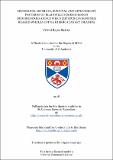Files in this item
Abundance estimate, survival and site fidelity patterns of Blainville’s (Mesoplodon densirostris) and Cuvier’s (Ziphius cavirostris) beaked whales off El Hierro (Canary Islands)
Item metadata
| dc.contributor.advisor | Aguilar de Soto, Natacha | |
| dc.contributor.advisor | Hammond, Philip S. | |
| dc.contributor.author | Reyes Suárez, Crístel | |
| dc.coverage.spatial | xi, 89 p. | en_US |
| dc.date.accessioned | 2018-06-18T11:38:09Z | |
| dc.date.available | 2018-06-18T11:38:09Z | |
| dc.date.issued | 2018-06-27 | |
| dc.identifier.uri | https://hdl.handle.net/10023/14189 | |
| dc.description.abstract | Beaked whales (Fam. Ziphiidae) comprise 22 different species, however due to their cryptic behaviour, information on these species is very limited. Beaked whales appear to be highly sensitive to anthropogenic noise, which can lead to mass strandings. The scarcity of knowledge about the abundance and population dynamics of most beaked whale species impedes the correct assessment of the effects that these impacts have on their populations. Coastal, year round populations of Blainville’s and Cuvier’s beaked whales were found in El Hierro (Canary Islands) in 2003. Long-term photo-ID studies have been conducted since then using a combination of land and at sea observations. Here I present the first results relating to site fidelity, abundance estimates and apparent survival for Blainville’s and Cuvier’s beaked whales in the Northeast Atlantic. The number of identifiable adults, i.e. animals with regular to very good photos and recognizable marks in the same area of the body, comprises 69 Blainville´s and 66 Cuvier´s beaked whales. Individuals that were captured in only one year are considered transients (T) while animals seen in multiple years are defined here as recaptured (R). Analysis of site fidelity patterns showed that 35% and 53% of the marked population on Blainville’s and Cuvier’s, respectively, were recaptured and form island-associated populations with a pattern of residence in the area. In Blainville’s, females spend longer periods in coastal waters than males and indeterminate whales (subadults or adult females never observed with calves). Males visit the area during shorter periods and there is an apparent hierarchy in individual male use of the area. Indeterminate individuals seem to emigrate after a 3 year period. These data coincide with results from Bahamas in showing a higher number of females than males with high site philopatry, and less philopatry in subadults. It has been proposed that these observations in Bahamas could be explained by males fighting for access to the female resident population for polygynous mating, and some subadults leaving the area. In Cuvier’s beaked whales, there is no apparent sexual segregation in the use of the area albeit a low number of calves challenge a robust identification of adult females. More data are needed to define social structure of the Cuvier’s beaked whale population. Mark-recapture methods were used to calculate abundance estimate and apparent survival in both species. Data was restricted to six years (2010 to 2015) in order to apply open and also closed population models that could account for heterogeneity in the data. Results of closed model estimates (Chapman analysis of two periods pooling data biannually: 2010-2013 and 2012-2015) are robust and provide best estimates corrected by the proportion of marked individuals of 33 (95% CI: 24-46) island associated Blainville´s beaked whales for both periods, and 53 (95% CI: 38-71, for 2010-2013) and 39 (95% CI: 34-44 for 2012-2015) island associated Cuvier´s beaked whales. POPAN open model analyses of the full period provides best estimates of total abundances of 103 (95% CI: 85-125) and 87 (95% CI: 73-103) for Blainville´s and Cuvier´s beaked whales, respectively. | en_US |
| dc.language.iso | en | en_US |
| dc.publisher | University of St Andrews | |
| dc.rights | Attribution-NonCommercial-NoDerivatives 4.0 International | * |
| dc.rights.uri | http://creativecommons.org/licenses/by-nc-nd/4.0/ | * |
| dc.subject | Beaked whales | en_US |
| dc.subject | Cuvier's beaked whale | en_US |
| dc.subject | Blainville's beaked whales | en_US |
| dc.subject | Abundance estimate | en_US |
| dc.subject | Survival | en_US |
| dc.subject | Site fidelity | en_US |
| dc.subject | Canary Islands | en_US |
| dc.subject | Photo-ID | en_US |
| dc.subject | Northeast Atlantic | en_US |
| dc.subject | Mark-recapture methods | en_US |
| dc.subject | Island-associated populations | en_US |
| dc.subject.lcc | QL737.C438R4 | |
| dc.subject.lcsh | Ziphiidae (Beaked whales) | en |
| dc.subject.lcsh | Blainville's beaked whale--Canary Islands--Counting | |
| dc.subject.lcsh | Ziphius cavirostris--Canary Islands--Counting | |
| dc.subject.lcsh | Whale populations--Canary Islands--Estimates | |
| dc.title | Abundance estimate, survival and site fidelity patterns of Blainville’s (Mesoplodon densirostris) and Cuvier’s (Ziphius cavirostris) beaked whales off El Hierro (Canary Islands) | en_US |
| dc.type | Thesis | en_US |
| dc.type.qualificationlevel | Masters | en_US |
| dc.type.qualificationname | MPhil Master of Philosophy | en_US |
| dc.publisher.institution | The University of St Andrews | en_US |
| dc.publisher.department | Natural Environment Research Council (Great Britain). Sea Mammal Research Unit | en_US |
The following licence files are associated with this item:
This item appears in the following Collection(s)
Except where otherwise noted within the work, this item's licence for re-use is described as Attribution-NonCommercial-NoDerivatives 4.0 International
Items in the St Andrews Research Repository are protected by copyright, with all rights reserved, unless otherwise indicated.


